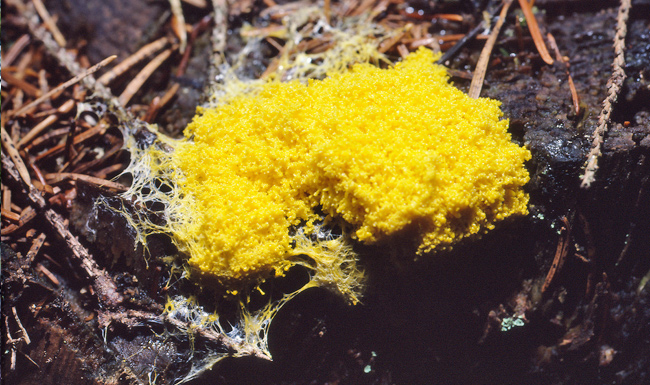
Myxomycetes, acellular slime moulds
Myxomycetes or so-called acellular slime molds are a group of organisms with worldwide distribution. Long ago they were referred to the animal kingdom due to the occurrence in their life cycle of a free-living stage with motile cells. They were later grouped with the fungi. Today myxomycetes together with dictyostelids (cellular slime moulds) and protostelids are referred to a separate kingdom, that has been demonstrated to be monophyletic. The assimilating stage of myxomycetes is a multinuclear protoplast, a plasmodium, which cytologically is one single cell. In some species it becomes several centimetres in diameter. In many species it is strongly pigmented. The plasmodium is motile and moves through a special technique based on protoplasma streaming. The organisms are heterotrophic, feeding on fungal spores, yeast cells, microscopic algae, or various small organic fragments. They are often found on decaying wood and in the litter layer in forests, but many species grow within decaying wood, emerging onto the surface to fructify. There are strong indications that myxomycetes in their amoeboidal stage may play an important ecological role in soil.
The plasmodium transforms into one or several fruitbodies. Fruitbodies are of different shapes dependent on species. They may be several cm across or microscopic. The largest fruitbodies are found in Brefeldia maxima and Fuligo septica which may reach 40-50 cm in extent. The smallest fruitbodies, not exceeding 25 µm in height, are those of Echinostelium bisporum. One single plasmodium may in some species give rise to several hundred genetically identical fruitbodies.
Although myxomycetes are found all over the world they seem to be most abundant in temperate regions. Some species are adapted to very special ecological niches, for example developing fruitbodies in the immediate vicinity of melting snow or under a snow layer. Dispersal by wind is important but insects and other arthropods appear to be the principal dispersal agents for many species. Some insects have their larval development in plasmodia and/or fruitbodies of certain myxomycetes. Roughly 1000 species are known in the world.
My own research on myxomycetes is focused on taxonomy and distribution.
The plasmodium transforms into one or several fruitbodies. Fruitbodies are of different shapes dependent on species. They may be several cm across or microscopic. The largest fruitbodies are found in Brefeldia maxima and Fuligo septica which may reach 40-50 cm in extent. The smallest fruitbodies, not exceeding 25 µm in height, are those of Echinostelium bisporum. One single plasmodium may in some species give rise to several hundred genetically identical fruitbodies.
Although myxomycetes are found all over the world they seem to be most abundant in temperate regions. Some species are adapted to very special ecological niches, for example developing fruitbodies in the immediate vicinity of melting snow or under a snow layer. Dispersal by wind is important but insects and other arthropods appear to be the principal dispersal agents for many species. Some insects have their larval development in plasmodia and/or fruitbodies of certain myxomycetes. Roughly 1000 species are known in the world.
My own research on myxomycetes is focused on taxonomy and distribution.
Selected publications:
Lado, C. & Eliasson, U.: Taxonomy and Systematics: Current knowledge and approaches on the taxonomic treatment of Myxomycetes: updated version.
In Stephenson, S. & Rojas, C. (eds), Myxomycetes: Biology, Systematics, Biogeography and Ecology. Second, updated edition. Chapter 8. Pp 269-324. Academic Press (2021). ISBN 978-0-12-824281-0.
Eliasson, U. & Svensson, J.: Myxomyceter i Sverige - till gg och kommentarer till checklista. (Additions to checklist of Myxomycetes found in Sweden). - Svensk Mykologisk Tidskrift 40(3): 2-7 (2019). (In Swedish with summary in English.)
Eliasson, U.: Myxomyceter i Sverige, en uppdaterad checklista (An updated checklist of Myxomycetes found in Sweden). - Svensk Mykologisk Tidskrift 39(3): 39-47 (2018). (In Swedish with abstract in English)
Lado, C. & Eliasson, U.: Taxonomy and Systematics: Current knowledge and approaches on the taxonomic treatment of Myxomycetes. In Stephenson, S. & Rojas, C. (eds), Myxomycetes: Biology, Systematics, Biogeography, and Ecology, pp. 205-251. Elsevier (2017).
Eliasson, U. H.: Review and remarks on current generic delimitations in the myxomycetes, with special emphasis on Licea, Listerella and Perichaena. - Nova Hedwigia 104: 343-350 (2017). (Published on line in April 2015; DOI:10.1127/nova_hedwigia/2015/0283).
Eliasson, U.: Coprophilous myxomycetes: Recent advances and future research directions. - Fungal Diversity 59: 85-90. (Published on line in Oct. 2012; DOI 10.1007/s13225-012-0185-6).
Eliasson, U.: Slemsvampar (Mycetozoa), en allmän översikt. (A general survey of slime moulds.) - Svensk Mykologisk Tidskrift 33(2): 9-15 (2012). (In Swedish with abstract in English.)
Eliasson, U.: Myxomyceter (Myxogastria) - allmänt om biologi, artbegrepp och inbördes fylogenetiska samband samt kort historik över inventering av arter i Sverige. (Myxogastria; biology, species concept and interrelationships, with a brief history of the inventory of species in Sweden.) - Svensk Mykologisk Tidskrift 33(3): 50-61 (2012). (In Swedish with abstract in English.)
Keller, H. W., Skrabal, M., Eliasson, U. H. & Gaither, T. W.: Tree canopy biodiversity in the Great Smoky Mountains National Park: ecological and developmental studies of a new myxomycete species of Diachea. - Mycologia 96: 537-547 (2004).
Eliasson, U. H.: Myxomyceten auf lebenden Blättern im tropischen Regenwald Ecuadors; eine Untersuchung basierend auf dem Herbarmaterial höherer Pflanzen. - Stapfia 73: 81- 84 (2000).
Eliasson, U. H. & Keller, H. W. 1999: Coprophilous myxomycetes: updated summary, key to species, and taxonomic observations on Trichia brunnea, Arcyria elaterensis, and Arcyria stipata. - Karstenia 39: 1-10 (1999).
Keller, H. W. & Eliasson, U. H.: Taxonomic evaluation of Perichaena depressa and P. quadrata (Myxomycetes) based on controlled cultivation, with additional observations on the genus. - Mycological Research 96: 1085-1097 (1992).
Eliasson, U. H., Keller, H. W. & Schoknecht, J. D.: Kelleromyxa, a new generic name for Licea fimicola (Myxomycetes). - Mycological Research 95: 1201-1207 (1991).
Eliasson, U. H.: The myxomycete biota of the Hawaiian Islands. - Mycological Research 95: 257-267 (1991).
Keller, H. W., Eliasson, U. H., Braun, K. L. & Buben-Zurey, M. J.: Corticolous Myxomycetes X: Ultrastructure and taxonomic status of Cribraria minutissima and C. confusa. - Mycologia 80: 536-545 (1988).
Eliasson, U. & Gilert, E.: A SEM-study of Listerella paradoxa (Myxomycetes). - Nordic Journal of Botany 2: 249-255 (1982).
Eliasson, U.: Patterns of occurrence of myxomycetes in a spruce forest in south Sweden. - Holarctic Ecology 4: 20-31 (1981).
Eliasson, U. & Lundqvist, N.: Fimicolous myxomycetes. - Botaniska Notiser 132: 551- 568 (1979).
Eliasson, U.: Recent advances in the taxonomy of Myxomycetes. - Botaniska Notiser 130: 483-492 (1977).
Eliasson, U.: Ecological notes on Amaurochaete Rost. (Myxomycetes). - Botaniska Notiser 129: 419-425 (1977).
Eliasson, U. & Svensson, J.: Myxomyceter i Sverige - till gg och kommentarer till checklista. (Additions to checklist of Myxomycetes found in Sweden). - Svensk Mykologisk Tidskrift 40(3): 2-7 (2019). (In Swedish with summary in English.)
Eliasson, U.: Myxomyceter i Sverige, en uppdaterad checklista (An updated checklist of Myxomycetes found in Sweden). - Svensk Mykologisk Tidskrift 39(3): 39-47 (2018). (In Swedish with abstract in English)
Lado, C. & Eliasson, U.: Taxonomy and Systematics: Current knowledge and approaches on the taxonomic treatment of Myxomycetes. In Stephenson, S. & Rojas, C. (eds), Myxomycetes: Biology, Systematics, Biogeography, and Ecology, pp. 205-251. Elsevier (2017).
Eliasson, U. H.: Review and remarks on current generic delimitations in the myxomycetes, with special emphasis on Licea, Listerella and Perichaena. - Nova Hedwigia 104: 343-350 (2017). (Published on line in April 2015; DOI:10.1127/nova_hedwigia/2015/0283).
Eliasson, U.: Coprophilous myxomycetes: Recent advances and future research directions. - Fungal Diversity 59: 85-90. (Published on line in Oct. 2012; DOI 10.1007/s13225-012-0185-6).
Eliasson, U.: Slemsvampar (Mycetozoa), en allmän översikt. (A general survey of slime moulds.) - Svensk Mykologisk Tidskrift 33(2): 9-15 (2012). (In Swedish with abstract in English.)
Eliasson, U.: Myxomyceter (Myxogastria) - allmänt om biologi, artbegrepp och inbördes fylogenetiska samband samt kort historik över inventering av arter i Sverige. (Myxogastria; biology, species concept and interrelationships, with a brief history of the inventory of species in Sweden.) - Svensk Mykologisk Tidskrift 33(3): 50-61 (2012). (In Swedish with abstract in English.)
Keller, H. W., Skrabal, M., Eliasson, U. H. & Gaither, T. W.: Tree canopy biodiversity in the Great Smoky Mountains National Park: ecological and developmental studies of a new myxomycete species of Diachea. - Mycologia 96: 537-547 (2004).
Eliasson, U. H.: Myxomyceten auf lebenden Blättern im tropischen Regenwald Ecuadors; eine Untersuchung basierend auf dem Herbarmaterial höherer Pflanzen. - Stapfia 73: 81- 84 (2000).
Eliasson, U. H. & Keller, H. W. 1999: Coprophilous myxomycetes: updated summary, key to species, and taxonomic observations on Trichia brunnea, Arcyria elaterensis, and Arcyria stipata. - Karstenia 39: 1-10 (1999).
Keller, H. W. & Eliasson, U. H.: Taxonomic evaluation of Perichaena depressa and P. quadrata (Myxomycetes) based on controlled cultivation, with additional observations on the genus. - Mycological Research 96: 1085-1097 (1992).
Eliasson, U. H., Keller, H. W. & Schoknecht, J. D.: Kelleromyxa, a new generic name for Licea fimicola (Myxomycetes). - Mycological Research 95: 1201-1207 (1991).
Eliasson, U. H.: The myxomycete biota of the Hawaiian Islands. - Mycological Research 95: 257-267 (1991).
Keller, H. W., Eliasson, U. H., Braun, K. L. & Buben-Zurey, M. J.: Corticolous Myxomycetes X: Ultrastructure and taxonomic status of Cribraria minutissima and C. confusa. - Mycologia 80: 536-545 (1988).
Eliasson, U. & Gilert, E.: A SEM-study of Listerella paradoxa (Myxomycetes). - Nordic Journal of Botany 2: 249-255 (1982).
Eliasson, U.: Patterns of occurrence of myxomycetes in a spruce forest in south Sweden. - Holarctic Ecology 4: 20-31 (1981).
Eliasson, U. & Lundqvist, N.: Fimicolous myxomycetes. - Botaniska Notiser 132: 551- 568 (1979).
Eliasson, U.: Recent advances in the taxonomy of Myxomycetes. - Botaniska Notiser 130: 483-492 (1977).
Eliasson, U.: Ecological notes on Amaurochaete Rost. (Myxomycetes). - Botaniska Notiser 129: 419-425 (1977).
UNO ELIASSON

University affiliation:
University of Gothenburg
Department of Biological and Environmental Sciences
Email:
uno.botan@gmail.com
Scientific publications:
Click here (pdf) >>